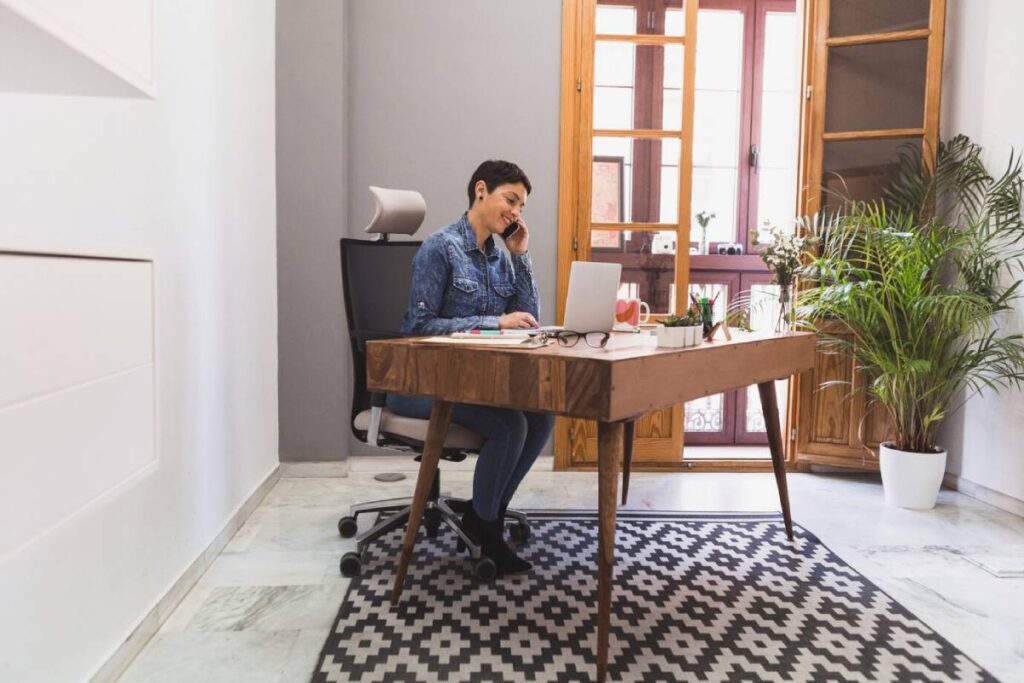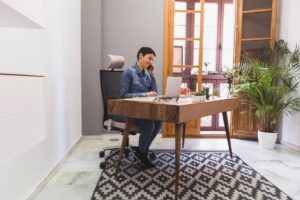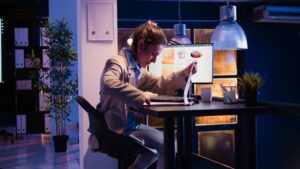The Business Blog

Creating a Distraction-Free Home Office Environment
Now remote work is beyond the trend. It has become central to professional life. With this shift, requiring a distraction-free home office is crucial. An organised workspace enhances productivity, concentration, and mental health. This blog will provide you with tips to eliminate distractions and design your workspace toward your best work. If you’re accustomed to working at home, or if it’s something new for you, here are tips to best optimise your space.
Key Benefits of a Distraction-Free Home Office
The appeal of remote work is its promise of flexibility. But it also brings challenges, especially distractions at home. Understanding the benefits of a distraction-free workspace is the first step to creating one.
Enhanced Focus and Productivity

A distraction-free workspace helps you achieve deep work. This means long periods of focus that lead to high-quality results. Distractions, like notifications or noise, disrupt this focus. They force your brain to shift gears, which reduces productivity and causes fatigue.
When your home office minimises distractions—with little noise and good lighting—you can work more efficiently and accurately.
Improved Work-Life Balance
A downside of remote work is the blurred line between work and personal life. Working from your couch or kitchen can make it hard to “log off” at the end of the day. A designated workspace helps your brain know when it’s time to work and when to relax. This separation promotes a healthier work-life balance.
By keeping work and personal spaces apart, you can set clear boundaries. This reduces stress, improves sleep, and boosts overall life satisfaction.
Increased Job Satisfaction
An environment that supports your productivity leads to higher job satisfaction. When you can focus, meet deadlines, and contribute well, it creates a positive loop. You feel more competent and fulfilled.
Workers in supportive remote environments often experience longer engagement and professional growth.
Why It Matters: Real-Life Applications
Consider Sarah, a marketing manager who started remote work during the COVID-19 pandemic. She faced many distractions, from social media to family interruptions. Her productivity dropped, and her stress rose.
By taking action—like setting up a quiet office space and using noise-cancelling headphones—Sarah regained control. Her productivity soared, and she felt more confident and satisfied. This change improved her career and her home life.
Additional Expert Tips & Common Mistakes to Avoid
Creating a distraction-free home office involves mindful choices about your day, tools, and habits.
Best Practices for a Productive Home Office
Designate a Specific Work Area
Choose a space dedicated to work. It can be a small desk in your bedroom or a corner of the living room. The key is consistency. Over time, your brain will link this area to work, making it easier to focus.
Invest in Ergonomic Furniture
Your comfort affects your concentration. Ergonomic furniture helps keep good posture and reduces strain. Important elements include:
- Adjustable chair with lumbar support
- Desk at the correct height
- Monitor at eye level
- Keyboard and mouse within reach
Though ergonomic furniture costs more, it pays off in productivity and health.
Utilise Natural Light
Natural light brightens a space and boosts mood and focus. If possible, set your workspace near a window to get daylight. Add soft, warm lighting in the evening to avoid eye strain.
Bonus tip: Add indoor plants. They enhance your space and improve air quality.
Common Mistakes to Avoid
Even the best remote workers can face pitfalls. Knowing these common mistakes can help you steer clear of them.
Overloading Your Workspace
Too many gadgets or papers can clutter your desk. Keep only essentials within reach: your laptop, notepad, and a water bottle. Use drawers or organisers for everything else. A tidy desk leads to a tidy mind.
Ignoring Breaks
The urge to work non-stop can be strong. But skipping breaks can backfire. Your brain needs rest to stay sharp.
Try the Pomodoro Technique: 25 minutes of focused work followed by a 5-minute break. After four cycles, take a longer break (15–30 minutes). This method can boost focus and prevent burnout.
Neglecting Communication
Remote work can lead to isolation. Avoid this by scheduling regular check-ins with teammates. Use tools like Slack, Teams, or Zoom. Be proactive in sharing updates or asking questions.
Strong communication builds trust and keeps you aligned with team goals.
Advanced Insights: Expert Recommendations
For those wanting to enhance their remote work setup, these strategies can help.
Implementing Technology Solutions
The right tools can cut distractions and streamline your work:
- Noise-cancelling headphones: Block ambient noise to help you concentrate.
- Task management apps: Use Asana, Notion, or ClickUp to keep tasks organised.
- Browser extensions: Use StayFocusd or Freedom to limit time on distracting sites.
- Time tracking software: Apps like RescueTime or Toggl help analyse how you spend time.
Establishing a Routine
Structure brings discipline. Start your day with a consistent morning routine—like a short walk, coffee, or journaling. Stick to regular hours and add rituals to signal the end of the workday, like closing your laptop or taking a moment outside.
Routines reduce decision fatigue and create a rhythm that supports productivity.
Personalising Your Space

Functionality is key, but add a bit of personality to your workspace. Personal touches like photos or art can boost motivation.
You can also use scent (like lemon or lavender), music, or ambient sounds to create an environment that supports focus.
Designing for Success at Home
Establishing a distraction-free home office isn’t only about aesthetics, it’s about curating an environment that encourages you to achieve. And the rewards — improved focus, better work-life balance, greater job satisfaction — are worth the effort.
We’ll start by pinpointing your biggest distractions and assessing your setup. From that, make small tweaks to shape your workspace. Your environment determines your actions; keep that in mind. When you optimise your space you prep yourself for success.
What changes can you make today to boost your productivity? Share your thoughts in the comments!









